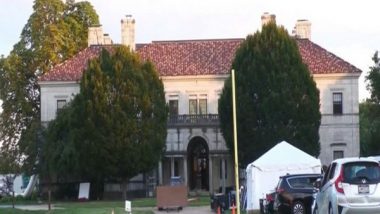[CLIP: Theme music] Rachel Feltman: Archaeology can reveal shocking similarities between modern-day humans and our most distant, ancient ancestors. But it just as often allows us awe-inspiring glimpses into feats our species accomplished without the aid of technologies we now take for granted. It can also force us to confront historical practices that shock our modern sensibilities—and leave us grappling with thorny ethical questions.
For Science Quickly , I’m Rachel Feltman. You’re listening to the final episode of our three-part Fascination series on extreme archaeology. If you’re just tuning in, make sure to circle back to the episodes we posted last Friday and the Friday before that.

You’ll hear about everything from the surprising sophistication of prehistoric stargazing to the study of ingenious ancient fishing techniques that have persisted to this day. On supporting science journalism If you're enjoying this article, consider supporting our award-winning journalism by subscribing . By purchasing a subscription you are helping to ensure the future of impactful stories about the discoveries and ideas shaping our world today.
Back again with us is the award-winning documentary filmmaker and journalist Kata Karáth. She’s taking us on one more adventure—this time to the top of a mountain with a climate so extreme it’s practically alien—to introduce us to archaeologists who study human sacrifice. Before we get started, a quick note about language: Quechua was the primary language spoken among the Inka, and its varieties are widely spoken today in the Andean regions where the Inka Empire extended.
Throughout this episode, we use Quechua words where possible. The pronunciations you’ll hear reflect the way the language is currently spoken by the descendants of the peoples who lived in the part of the Inka Empire that included what is now northern Argentina. We’ve also provided the corresponding Spanish or English words and spellings in the transcript where appropriate.
We want to make sure to mention, by the way, that the Quechua language family includes many different local varieties and that these are and were only some of the languages spoken among Indigenous communities in the Andes. You can check out this episode’s transcript for more detailed notes on language. We’d like to extend our thanks to Carlos Molina-Vital, a linguist and language teacher who specializes in Quechua, for his help in this area.
Lastly, please be advised that this episode contains content that may disturb some listeners, including discussions of child sacrifices. You can find a more detailed content warning in this episode’s show notes. [CLIP: The wind howls] Diego Sberna: In the summit you can see all the puna, so you have a 360 degree of vision.
It’s absolutely amazing that you see all the puna. Kata Karáth: That’s Diego Sberna, an anthropologist based in Argentina who specializes in high-altitude archaeology. The puna are the cold, grassy highlands typical of the Central Andes.
They are dressed in every shade of red and yellow. [CLIP: “Those Rainy Days,” by Elm Lake ] Sberna: And maybe if you look well, also—far, far away, you can see the beach of Chile, the Pacific Ocean. Karáth: Diego is talking about the view from the highest archaeological site in the world: it’s perched atop Llullaillaco, a roughly four-mile-high [at about 4.
2 miles, or 6.7 kilometers] sleeping volcano that sits along the border of northern Argentina and Chile. Its summit was the final resting place of Inka [in English: Inca] human sacrifices.
By the way, while the mountain is known today as Llullaillaco, following Spanish conventions, its name at the time of the Inka was likely Llullayllaku. You will hear me use both words throughout this episode, depending on whether we’re talking about modern or Inka times. [This script uses the spelling “Llullaillaco” when discussing the mountain and expeditions to it in modern times.
The spelling “Llullayllaku” is used when referring to the burial site and pilgrimage place during the time of the Inka.] This next part may be disturbing for some listeners. Sberna: We found traces of chicha [in Southern Quechua: aqha ], which is alcohol.
The Inka priests prepared them to be sleepy when they were sacrificed on the summit. We found that the children also had coca [in Southern Quechua: kuka ] leaves, probably chewed as part of the ceremony, but [I imagine] also against altitude sickness. Karáth: According to a prominent hypothesis among archaeologists, these were the last moments of three children who were sacrificed more than 500 years ago at the summit of Llullayllaku.
Researchers have estimated that the children—a teenage girl, along with a young boy and girl—had likely walked nearly 900 miles [more than 1,400 kilometers] by this time. They started from Qusqu in what is now Peru. Today that city is known in English as Cuzco.
[“Qusqu” is the official Southern Quechua spelling for the likely name of the city during the Inka Empire, though it is often written “Qosqo” as a result of Spanish influence. Cuzco can also be spelled “Cusco.”].
At the time Qusqu was the capital of Tawantinsuyu [in Spanish: Tahuantinsuyo], as the Inka called their empire. They likely stopped at various sacred sites during their monthslong pilgrimage. Then they were sacrificed as part of a ceremony called qhapaqucha [in Spanish: capacocha ].
It’s thought that these sacrifices happened for a number of different reasons: for instance, to provide offerings to the gods or to mark key events in the empire. Something to keep in mind here is that much of researchers’ understanding of day-to-day life in the Inka Empire comes from accounts written by colonizers from Spain. Though some sources from the time period do include Inka voices, many don’t.
And it’s important to consider the limitations and intentions behind these foreign accounts. For example, as one archaeologist has described, accounts of Inka spiritual life were often written by Catholic clerics, quote, “in order to destroy the very practices they describe.” We should note that these accounts aren’t the only means of understanding the traditions of the Inka Empire and of the Andean peoples who became part of it.
Elements of the Indigenous belief systems that predated the arrival of the Spanish are still alive in many Andean communities today. In 1999 an international team of high-altitude archaeologists unearthed the Llullayllaku children’s highly intact mummified remains. This allowed for very detailed scientific analyses.
It also fueled ongoing debates about excavating ancient sites and studying, displaying and storing ancient human remains, especially those with ties to modern-day Indigenous groups. Diego, by the way, is the director of the UNESCO Qhapaq Ñan , Andean Road System World Heritage site in Salta, Argentina. He used to work at the Museum of High Altitude Archaeology in Salta, where the mummified Llullayllaku children are currently on display.
Diego and his colleagues are trying to understand why the Inka worshipped mountains—and how their special connection to the apukuna , or mountain deities, might have helped them establish the largest-ever empire in the Americas. [CLIP: The wind howls] Karáth: Only the most determined archaeologists can visit the remote Llullaillaco—well, determined archaeologists and wanaku , which are wild ancestors of llamas. In English they’re known as guanacos, a word that comes from Spanish.
[CLIP: Guanacos call] Karáth : Llullaillaco is so difficult to reach because it’s truly a mountain of extremes. It’s not only one of the highest active volcanoes in the world—it also lies on the edge of the Atacama Desert, one of the driest places on Earth. [CLIP: Rolling thunder] Karáth: Its harsh beauty comes with a steep price.
The weather can change in a flash. Lightning storms are common, and winds can reach many tens of miles [10 miles is about 16 kilometers] per hour. Temperatures can drop to –22 degrees Fahrenheit [–30 degrees Celsius] and sometimes even lower.
Sberna: One afternoon a blizzard suddenly started in the mountain, and it was so freezing, so cold that we had to run down the mountain, and when we reached our 4x4 car and tried to start the engine, the cold was so strong that the gasoline in the tank froze. Karáth: Get caught in the wind and chill, and you might lose some fingers or toes to frostbite. And so high-altitude archaeologists such as Diego are trained mountaineers as well.
In addition to monitoring the precarious weather conditions, they must watch out for altitude sickness, caused by the reduction in oxygen. The most serious cases can lead to pulmonary or cerebral edema, which can be deadly. They pack lightly and work swiftly.
Still, this imposing peak once drew its share of visitors. Located in the southern region of the Inka Empire, it was a wak'a , which refers to a sacred site or object. At the foothills of Llullayllaku laid a sort of base camp for imperial messengers and procession participants, including lodgings for travelers and a cemetery.
Multiple sections of the Qhapaq Ñan Inka road system led to it, likely providing a clear path all the way up to the summit. [CLIP: “Let There Be Rain,” by Silver Maple ] Karáth: But before we talk more about what it’s like at the top of the mountain, let’s learn about the lives of the children of Llullayllaku. Who were they? Why were their lives, like those of so many others, sacrificed? Even before the Inka many Andean cultures considered the whole landscape—including lakes, rivers and springs—sacred, because it nurtured their crops and livestock.
And with mountains rising along the horizon as far as the eye can see, their prominent role continues among many communities in the Andes today. The Inka believed that apukuna had power over water—and as a result, the fertility of the land. Mountains were considered connection points that linked the Earth, the underworld and the sky.
They served as homes to gods and spirits that controlled meteorological and geological phenomena. To maintain a good relationship with the mountains, Diego says, the Inka believed that offerings must be made—and they had to be valuable. Sberna: The children who were chosen to be offered to the mountain were usually sons or daughters of chiefs, so they were the children of important people [in an] Inka village, [or] they were from the [tribes] that the Inka conquered.
The tribal leaders were told to make a tribute to the Inka and send their own children. Karáth: This meant that children from all over the Inka Empire were chosen, often in an effort to seal or maintain political alliances, and sent to Qusqu to be prepared to be sacrificed. Sberna: I know that the boy was probably Mapuche, from this Indigenous group from the south of Chile and Argentina, because they’ve studied his DNA, and it contained the genetic traces of the Mapuche people.
Karáth: Archaeologists believe the boy and the younger girl were around four or five years old, while the older girl was probably around 13. Sberna: And when you see her, it’s quite spectacular because she is like a Sleeping Beauty. Karáth: I saw her for myself.
The girl known as the Llullaillaco Maiden [researchers generally refer to the Maiden using the Spanish spelling of the mountain’s name] was sitting cross-legged with her arms folded in a glass cylinder on the second floor of the High Altitude Archaeology Museum. Her small head was tilted over her right shoulder, with some of her tightly braided black hair gently falling over her closed eyes. You may remember I mentioned earlier that some believe the children should not be displayed; we'll talk more about that soon.
All three children were buried in a shrine on a ceremonial platform just a few feet below Llullayllaku’s summit. The child referred to as the Llullaillaco Boy [researchers generally refer to the Boy using the Spanish spelling of the mountain’s name] was found tied up, his head resting over his knees in a fetal position, while the other girl’s face and upper body were burned, suggesting she was struck by lightning after her death. Archaeologists generally refer to her as the Girl of Lightning.
Just as Diego says, the children’s bodies and the offerings buried with them are eerily well-preserved. The color of their garments is still vibrant. The white feathers on the Boy’s headdress look like they were plucked from a bird yesterday.
The golden and silver human and llama figurines buried with them are still whole and shiny. Five hundred years later these children are frozen in time. Steve Schmidt: Why didn’t they decay? Karáth: That’s Steve Schmidt, a professor at the University of Colorado Boulder, who specializes in the microbes of extreme environments.
Schmidt: Well, the key to that, in my opinion, is that they were buried down about, I think, at least a meter [about 3.3 feet] under the ground on top of the volcano. And so it’s a combination of the really cold temperatures at that elevation and the fact that even though it snows up there—and there’s actually snow often on the ground on the peak of those volcanoes—most of the snow sublimates when the sun hits it, so it’s not soaking in.
So the mummies were, like, in a very cold, frozen environment, and they were kept dry because they were far enough down that water never penetrated to where they were. Karáth: When Steve first saw photos of the children of Llullayllaku, he was deeply intrigued. What place on Earth could be so extreme that it forced even microbes—some of which thrive in the planet’s harshest environments—to stand still? Since then he has led multiple expeditions to Llullaillaco to find answers.
As it turns out, conditions near the summit are out of this world—almost literally. Schmidt: It’s a good environment as a proxy, or an analogue environment, for something like Mars because the other thing you really have at those elevations is extreme UV radiation. Karáth: That prevents most microbial life from flourishing.
Steve says the mountain supports a few lichens, which are born of symbiotic partnerships between fungi and cyanobacteria, but even these organisms likely grow very, very slowly. And when it comes to their role in decomposition, microbes need liquid water—which is in short supply on Llullaillaco. Schmidt: Usually bodies decay sort of from inside out because they stay moist inside, and you get all this stuff growing.
But there’s also things that are colonizing the surface as long as there’s some water around, and, you know, if you bury bodies in just regular soil, there’s plenty of moisture for them to decay—to support the microbial growth that decays them. Karáth: As for the moisture the children’s bodies brought into the ground with them, the summit’s extreme cold froze those liquids quickly enough to stop the microbial life within their guts. But if Llullaillaco is so extreme that it’s literally an analogue for a Martian environment, how on Earth could the Inka have reached its summit centuries ago, without any modern climbing equipment? Diego and his colleagues recently decided to find out the hard way.
[CLIP: “None of My Business,” by Arthur Benson ] Karáth: Jaime Soriano, a local mountain guide of Indigenous heritage, joined Diego’s colleague Christian Vitry, an archaeologist who was also part of the 1999 excavation, in donning some traditional Inka gear. They attempted to climb Llullaillaco themselves. It’s not uncommon for archaeologists to carry out experiments that test ancient equipment or processes such as sailing roughly 1,000 miles on a Viking warship replica to probe various hypotheses about Norse seafaring.
More recently, Greek marines put on Bronze Age suits of armor to test their mettle in combat. Diego says the idea of re-creating the Inka mountaineering experience was born many years ago, but the project only came to be in March 2023, after the research group secured funding. The team prepared for six months, commissioning Inka clothing and shoes from local artisans based on archaeological artifacts.
Then the researchers traveled to the mountains to set up a base camp and acclimate. Finally they put on the replicas of 500-year-old mountaineering outfits and set off for Llullaillaco’s summit. Sberna: What we have found out during our recent experimental archaeology project in March 2023 is that the Inka probably only climbed mountains when there was good weather and no snow—or just very little snow—because when we finally found the Inka boots and poncho, they were very good, like today’s mountaineering clothes, but they were not waterproof enough for the snow, you know? They could handle some rain but not the snow.
Karáth: While the archaeologists never reached the summit because of unusually heavy snow and a lightning storm, Diego says the experience was enriching, and they consider it a success. Their experiment suggests that the Inka’s clothing may not have been totally winter-proof, but they were still surprisingly well-outfitted for the harsh conditions. The replica ponchos were made of tightly woven alpaca and vicuña wool that blocked wind and rain and kept the researchers comfortable in both hot and cold temperatures.
But the key to the Inka’s mountaineering success, Diego says, was their multilayered high-altitude footwear. They combined wool with plant fibers and human hair, making for a sturdy construction that kept out cold and moisture. Researchers also believe it’s possible these types of shoes possessed symbolic meaning, in part because of the use of human hair, which was thought to contain its source’s knowledge and provide the wearer with protection.
And the fact that the Inka managed to conquer mountains might have also helped them subsume other Andean cultures, which they did using multiple strategies, including conquest. Sberna: The Inka were the first civilization that climb up to the summit of the [Andes] mountains. Pre-Inka [civilizations] worshipped the mountains from below—from the foothills or valleys of mountains.
But to install and legitimize their power when conquering other Andean culture, they decided to worship the [mountains] from the top. This is also why the capacocha ceremonies—where they sacrificed the children—are held on mountain summits. Karáth: The Inka went to great lengths—or in this case, great heights—to make sure their revered sacrifices reached the realm of the apukuna .
They often brought the carefully selected individuals to summits higher than three miles [about 5 kilometers]. In the modern day bringing those individuals down from the mountaintops has stoked fierce debate. Expedition leaders have argued that these remains are valuable in helping archaeologists understand the past.
And Diego says that keeping the remains of the children of Llullayllaku at the museum protects them from grave robbers and mining on the mountain and shields them from the potential impacts of climate change on the summit’s conditions. But some people believe the remains should not have been removed from the mountaintop, let alone displayed. While expedition leaders and museum staff have said they worked with local Indigenous communities during the excavation and exhibition, some Indigenous people strongly opposed both.
In 1999 Kolla Community Los Airampos, a local Indigenous association, filed a complaint. The group’s members consider themselves descendants of people who lived in the part of the Inka Empire that included Llullayllaku. They argued that they had not been consulted before the expedition and that the burial site is sacred to them.
A federal attorney dismissed the complaint, saying the expedition had met its legal obligations—a claim that’s been disputed. The opposition didn’t end there, however. In 2005 a group that included members of Indigenous communities from Argentina and other countries released a statement denouncing the expedition as, quote, “desecration and looting.
” They also said, “We condemn and denounce before world public opinion the attempted exhibition of these Children, human beings with the right to rest in peace and to respect for their privacy.” In an article in the Guardian from that year, Rogelio Guanuco—then the head of the Indigenous Association of the Argentine Republic—was quoted as saying that the project was “a violation of our loved ones.” Those involved, he said, “should never have profaned the sanctuary, and they should not put our children on exhibition as if in a circus.
” The archaeology community has also raised ethical and legal concerns about the removal and display of the children’s mummified remains. After the removal of the bodies and the opening of the exhibition at the Museum of High Altitude Archaeology, some archaeologists and museologists arranged meetings with Indigenous communities, collaborating on recommendations that encouraged respect for sacred sites and the inclusion of Indigenous people in heritage management. A declaration signed in 2005 specifically recommended against the display of human remains in museums.
Diego says that high-altitude archaeology is practiced very differently today. Argentine archaeologists have decided not to carry out excavations at Indigenous high-altitude sanctuaries anymore nor bring down any mummified human remains they find in these sacred spaces in the future. They are now only doing surface examinations on Andean summits, looking for material evidence to help them better understand how the Inka connected sacred landscapes.
Argentina has ratified International Labor Organization Convention 169, which says that Indigenous people should be consulted in matters that affect them, and has made some efforts to address Indigenous rights through constitutional reform. There have been cases in which human remains were returned to Indigenous groups in Argentina, and national legislation passed in recent decades has helped facilitate that process. The province of Salta, where the museum is located, isn’t required to adhere to these federal laws, and Christian Vitry—the archaeologist who was part of the 1999 expedition—says that the specialized technology and personnel needed to preserve these remains in the communities calling for their return isn’t currently available.
But calls for restitution, including from Kolla groups like the community of Tolar Grande, have continued. And in 2022 the country’s National Institute of Indigenous Affairs officially declared Llullaillaco an Indigenous sacred site. María Patricia Ordoñez Alvarez is a forensic anthropologist and archaeologist at the University San Francisco of Quito in Ecuador.
She has been researching the collection and display of human remains from the Andes and the role of colonialism in those practices. María Patricia says it’s tricky to figure out which stakeholders have the right to make decisions about mummified remains in the Andes today, especially because groups of people in the region have moved around a lot in the time since these children were buried. Some archaeologists argue that it’s challenging to link the children to one specific Indigenous group because of the nature of the qhapaqucha ceremony.
They could have come from any geographic region that made up the vast Inka Empire, from parts of present-day Colombia to what is now Chile. María Patricia Ordoñez Alvarez: When you discuss human remains, you’re not discussing stuff in the present; you’re discussing versions of that town in the past. You need to consider the actors in that particular community, that particular chronology and how those remains came to be where they are.
The people that get to be involved in decision-making need to be from different places—not just from the closest geographical position but rather people that could have a connection to those remains that are not necessarily close by, people that could feel represented by them. Karáth: María Patricia says it’s also crucial to remember that different peoples have and had very different relationships to the dead and that there isn't only one way to think about these issues. Ordoñez Alvarez: The concept itself of thinking about human remains being exhibited in terms of ethics is a complicated thing.
We have a lot of other things to consider before just thinking of Western ethics in regards to the body. Karáth: Another important question to keep in mind when it comes to exhibiting remains, María Patricia says, is who benefits: Is it the Indigenous communities whose heritage is being displayed, or is it someone else? Ordoñez Alvarez: Who’s benefiting from them being exhibited, from the entrance fee, from all that? Karáth: María Patricia believes the ideal approach is to consider each decision about human remains as its own unique case—a decision to be made in conversation with stakeholders and with an eye to the specific context involved rather than according to a one-size-fits-all rule. And most importantly, she says, respect for stakeholder communities and their heritage must govern the whole process.
[CLIP: “Moonlit Serenity,” by Martin Landh ] Today the Llullayllaku children still receive visitors, more than 500 years after their sacrifice, traveling in time from a mighty empire built above the clouds. They provide a window to the past, but they also remind us of the care we must take when gazing back through the lens of modernity. Just because these children have been immortalized doesn’t mean we’ll ever truly understand how they lived their lives—or the significance of their deaths.
[CLIP: Theme music] Feltman: This concludes our three-part Fascination series on the intriguing world of archaeology. If you liked this series, do us a favor and leave us a rating and a review wherever you’re listening right now. You can also send us your feedback at ScienceQuickly@sciam.
com . We’ll be back on Monday with a roundup of the science news you might have missed while daydreaming about archaeological dive sites and ancient stargazers. Speaking of stargazers, join us on Wednesday for a chat with an expert on the looming threat of falling space junk.
And you definitely don’t want to miss next Friday’s episode, where a very special guest—who’s basically science-podcast royalty—will tell us about their exploration into one of the last taboos in sexual-health research. Science Quickly is produced by Jeff DelViscio, Fonda Mwangi, Kelso Harper, Madison Goldberg and me, Rachel Feltman. Our theme music was composed by Dominic Smith.
Shayna Posses and Aaron Shattuck fact-checked this series. This episode was reported and hosted by Kata Karáth. Special thanks to María Luz Endere and Carlos Molina-Vital for their assistance with parts of this script.
For Scientific American ’s Science Quickly , I’m Rachel Feltman. Thanks for listening..



















